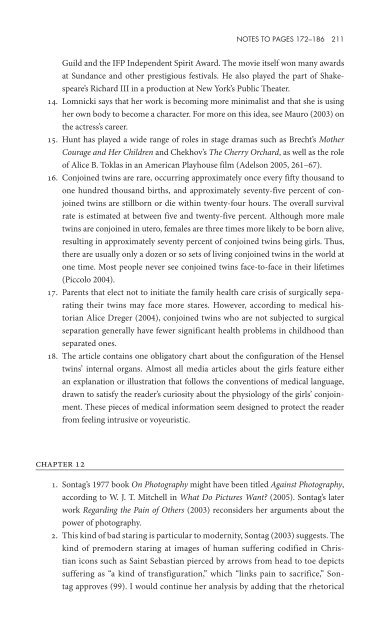Staring how we look sobre la mirada.pdf - artecolonial
Staring how we look sobre la mirada.pdf - artecolonial
Staring how we look sobre la mirada.pdf - artecolonial
You also want an ePaper? Increase the reach of your titles
YUMPU automatically turns print PDFs into web optimized ePapers that Google loves.
FACES 101<br />
will make an equal c<strong>la</strong>im. In these readings, staring at a face creates a responsibility<br />
arising from our shared humanity.<br />
For other modern thinkers, <strong>how</strong>ever, face-to-face re<strong>la</strong>tions imperil us. In<br />
the tradition of human re<strong>la</strong>tions <strong>la</strong>id out in Hobbes, Machiavelli, and Hegel,<br />
Sartre sees faces as threats to be read. “The body advances,” he writes in<br />
his essay on faces, “bearing the sacred object bet<strong>we</strong>en its shoulders on its<br />
neck” (Sartre 1956, 159). All staring is domination in which “our faces rule”<br />
and reveal “our darker passions” (159). The fleshly materiality of the other’s<br />
face—its immanence—is disturbing, even repulsive. Faces have “voracity”<br />
and are “pierced with greedy holes” and make “objects leap backwards”<br />
(161). Faces of other people diminish the self in Sartre’s account of faceto-face<br />
interaction, in which our own visage is puny, stuck in a narcissistic<br />
moment and unable to realize all the potency it witnesses in another face.<br />
The “I” is intimidated and resentful in the presence of another’s face, limited<br />
because “I do not see my own face” (159). “I carry [my face] in front of me<br />
like a secret which I have not fathomed,” Sartre begrudgingly observes, “and<br />
it is the faces of others, instead, which teach me what mine is like” (159).<br />
As <strong>we</strong> saw in chapter 5, one’s own face then is an epistemological problem,<br />
solved only by analogy.<br />
This anxiety of facedness intensifies in the modernist literature of alienation.<br />
In 1962, for example, the Polish émigré writer Witold Gombrowicz<br />
characterized human interaction as “a relentless duel of face-making, face<strong>we</strong>aring,<br />
face-imposing” (Newton 1998, 244). In this grim mutuality of facial<br />
fashioning, the sufficiency of our own face is forever compromised by<br />
the intrusive face of another, always demanding a reckoning. Such “facial<br />
c<strong>la</strong>ustrophobia” is defensive posturing seemingly specific to modern urban<br />
anonymity, where <strong>we</strong> are assaulted by alien faces at intimate range—as anyone<br />
who has taken a subway at peak hours knows all too <strong>we</strong>ll (248). With their relentless<br />
particu<strong>la</strong>rities, the faces of others engulf us with pleas for recognition,<br />
what one critic calls “the ordeal of intersubjectivity as physiognomy” (249).<br />
RECOGNIZING FACES<br />
Faces, then, are texts <strong>we</strong> engage or resist, opportunities for reve<strong>la</strong>tion or refusal.<br />
For Buber and Levinas, the faces of others beckon and bond us to one<br />
another. For Sartre and Gombrowicz, faces confront and alienate us from<br />
one another. We stare at faces to differentiate friend from foe, familiar from<br />
strange, invitation from rejection, anger from adoration, comic from tragic.<br />
The ability to recognize faces is essential in human interaction, indeed to<br />
our survival. Much of the entire brain as <strong>we</strong>ll as specialized areas recognize


